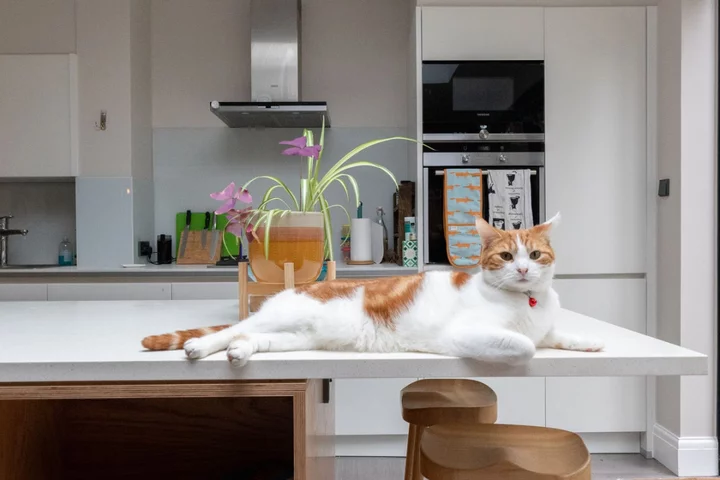If you have a furry friend at home, it’s safe to say they are your best friend – and just as much a part of the family as anyone else.
Indeed, according to home renovation and design platform, Houzz, more than three-in-five pet owners actively consider their pets when making decisions about home renovations, with designers on the platform noting a rise in pet-specific requests during home remodels.
“Whether it’s considering the best materials or layouts for our furry friends, or even integrating bed nooks, built-in dog showers or clever feeding stations, pets are an important consideration when designing a home that works for all the family,” says Katie Greenhalf, director at KG Lifestyle & Interiors.
“And as a result, people are keen to integrate items for them within their interior design scheme,” she enthuses.
Bespoke storage is all the rage
“For many people, storage is a key part of designing where they live – and considering your pet within this, is integral to a design that works for everyone in the home.
Greenhalf continues: “We’ve had clients request bespoke cupboards in the kitchen for a pet’s food; easily accessible for pets but also hidden away to keep things clean and tidy, and tucked away from toddlers too; integrated dog showers into the utility room and creating dog beds in the under-stairs area.”
Stylish sleep spaces are trending
For proud pet owners, dedicated spaces for pets are no longer hidden away, but are now at the centre of the design. According to Houzz’s survey, a quarter of pet owners have created a built-in nook for their pet’s bed.
“It isn’t as crazy as it might sound, as a dedicated nook can be positioned out of the way, rather than in the middle of the floor like standard pet beds and cushions,” explains Amanda Pollard, senior editor, Houzz.
“It also allows owners to locate their pet’s bed in a kitchen or living space, rather than having them sleep in a separate space away from family life.”
If you’re thinking about commissioning a bespoke piece of furniture for your living room, she suggests including an integrated sleep space for your dog – so it ties into the design of your room.
“For furry friends of the smaller variety, such as cats or petite pooches, you can carve out an area in a sideboard for a little built-in bed,” suggests Pollard.
A-list access is also top of the agenda
And it’s not just sleep spaces being incorporated into design plans either – how pets can get in and out of your home is another important factor to consider.
Especially with big swathes of glazing becoming increasingly popular, deciding where the humble old cat flap should go can be a slight hurdle.
Dominic McKenzie, director at Dominic McKenzie Architects came up with an innovative idea to overcome this. “We recently designed a house with wall-to-wall glazing across the rear elevation, but the owners’ cat needed a way to get in and out.
“We devised this special entrance through one of the cupboard doors in the kitchen, which leads onto a cat flap to the outside,” he explains. “We made the cat’s doorway house-shaped to give it a special character – the cat is very happy.”
Homeowners are always very keen to make their pets’ lives better as part of a renovation – as well as everyone else in the family, says McKenzie. “There’s usually a dedicated area devoted to the pet – and often their ways in and out of the property are high on the list of priorities when planning the project!”
But what if there isn’t any space on the ground floor for a cat flap?
Leah Chisnall, interior design project manager for Absolute Project Management, shares a creative approach for cat access in these instances…
“We’ve had two projects that included rear extensions with beautiful full-length glazing, and no space for a cat flap,” says Chisnall. “As a solution, we created cat flaps on the first floor (in a study and a bathroom) and included bespoke cat staircases from the first floor to the garden, for the family cats to use.”
Feeding stations are increasingly fashionable
And for those muddy paws and messy food bowls, innovative spaces for feeding and bathing are also high on the renovation wish list.
According to Houzz’s survey, one in five homeowners have added a built-in pet area for bathing or feeding into their homes – and for Absolute Project Management, it’s a top request from recent clients.
“The dog featured here is the very lovely Biscuit, belonging to one of our previous clients,” discloses Chisnall. “As part of their terrace house renovation, we converted a fairly snug ground-floor WC into a dog shower room.
“We built a short tiled shower wall to enclose the space, fitted a stone (splash-proof) shelf for shampoo bottles and fur brushes, hooks for towels and dog leashes, and made sure the shower waste was large enough (with an adequate catcher) for the excess dog fur!” explains Chisnall.
Cats aren’t missing out on dedicated spaces either, as Leah shares another project where her team created a beautiful cat litter room for a client.
“We carved out a small space in an under-stairs cupboard with a hole in the hallway door for the cat to get in – and beautiful stone flooring for the litter box to go on,” says Chisnall. “It was a very luxe and practical solution to keep it out of sight!”
Read MoreCharity boss speaks out over ‘traumatic’ encounter with royal aide
Ukraine war’s heaviest fight rages in east - follow live
Sex Education season 4: How vintage finds help characters get their unique style
Groundbreaking migraine treatment offers ‘new hope’ for patients
‘Millions of women and girls suffer severe pain’ during periods – research finds

